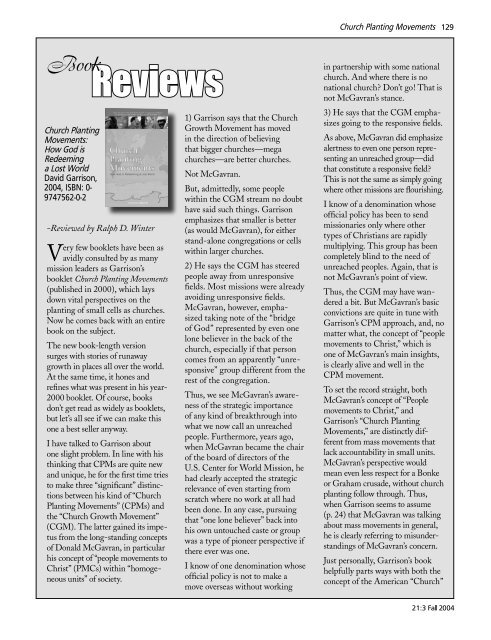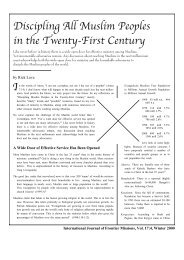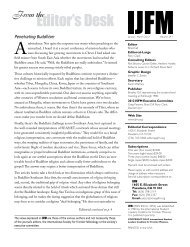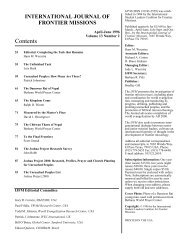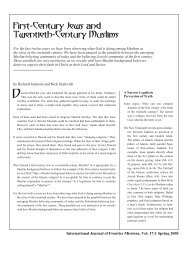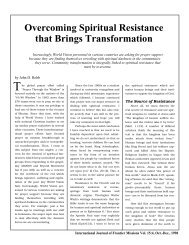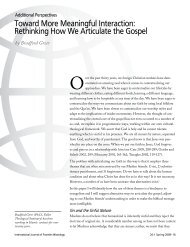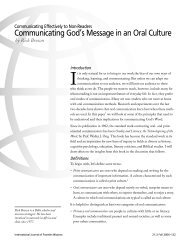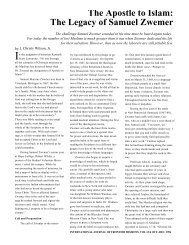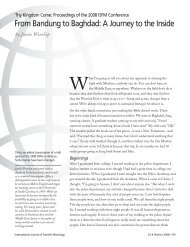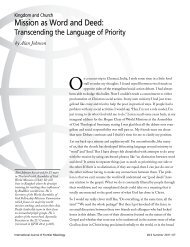Book Review: Church Planting Movements. - International Journal of ...
Book Review: Church Planting Movements. - International Journal of ...
Book Review: Church Planting Movements. - International Journal of ...
Create successful ePaper yourself
Turn your PDF publications into a flip-book with our unique Google optimized e-Paper software.
<strong>Church</strong> <strong>Planting</strong> <strong>Movements</strong> 129<br />
<strong>Book</strong><br />
<strong>Review</strong>s<br />
<strong>Church</strong> <strong>Planting</strong><br />
<strong>Movements</strong>:<br />
How God is<br />
Redeeming<br />
a Lost World<br />
David Garrison,<br />
2004, ISBN: 0-<br />
9747562-0-2<br />
-<strong>Review</strong>ed by Ralph D. Winter<br />
Very few booklets have been as<br />
avidly consulted by as many<br />
mission leaders as Garrison’s<br />
booklet <strong>Church</strong> <strong>Planting</strong> <strong>Movements</strong><br />
(published in 2000), which lays<br />
down vital perspectives on the<br />
planting <strong>of</strong> small cells as churches.<br />
Now he comes back with an entire<br />
book on the subject.<br />
The new book-length version<br />
surges with stories <strong>of</strong> runaway<br />
growth in places all over the world.<br />
At the same time, it hones and<br />
refines what was present in his year-<br />
2000 booklet. Of course, books<br />
don’t get read as widely as booklets,<br />
but let’s all see if we can make this<br />
one a best seller anyway.<br />
I have talked to Garrison about<br />
one slight problem. In line with his<br />
thinking that CPMs are quite new<br />
and unique, he for the first time tries<br />
to make three “significant” distinctions<br />
between his kind <strong>of</strong> “<strong>Church</strong><br />
<strong>Planting</strong> <strong>Movements</strong>” (CPMs) and<br />
the “<strong>Church</strong> Growth Movement”<br />
(CGM). The latter gained its impetus<br />
from the long-standing concepts<br />
<strong>of</strong> Donald McGavran, in particular<br />
his concept <strong>of</strong> “people movements to<br />
Christ” (PMCs) within “homogeneous<br />
units” <strong>of</strong> society.<br />
1) Garrison says that the <strong>Church</strong><br />
Growth Movement has moved<br />
in the direction <strong>of</strong> believing<br />
that bigger churches—mega<br />
churches—are better churches.<br />
Not McGavran.<br />
But, admittedly, some people<br />
within the CGM stream no doubt<br />
have said such things. Garrison<br />
emphasizes that smaller is better<br />
(as would McGavran), for either<br />
stand-alone congregations or cells<br />
within larger churches.<br />
2) He says the CGM has steered<br />
people away from unresponsive<br />
fields. Most missions were already<br />
avoiding unresponsive fields.<br />
McGavran, however, emphasized<br />
taking note <strong>of</strong> the “bridge<br />
<strong>of</strong> God” represented by even one<br />
lone believer in the back <strong>of</strong> the<br />
church, especially if that person<br />
comes from an apparently “unresponsive”<br />
group different from the<br />
rest <strong>of</strong> the congregation.<br />
Thus, we see McGavran’s awareness<br />
<strong>of</strong> the strategic importance<br />
<strong>of</strong> any kind <strong>of</strong> breakthrough into<br />
what we now call an unreached<br />
people. Furthermore, years ago,<br />
when McGavran became the chair<br />
<strong>of</strong> the board <strong>of</strong> directors <strong>of</strong> the<br />
U.S. Center for World Mission, he<br />
had clearly accepted the strategic<br />
relevance <strong>of</strong> even starting from<br />
scratch where no work at all had<br />
been done. In any case, pursuing<br />
that “one lone believer” back into<br />
his own untouched caste or group<br />
was a type <strong>of</strong> pioneer perspective if<br />
there ever was one.<br />
I know <strong>of</strong> one denomination whose<br />
<strong>of</strong>ficial policy is not to make a<br />
move overseas without working<br />
in partnership with some national<br />
church. And where there is no<br />
national church Don’t go! That is<br />
not McGavran’s stance.<br />
3) He says that the CGM emphasizes<br />
going to the responsive fields.<br />
As above, McGavran did emphasize<br />
alertness to even one person representing<br />
an unreached group—did<br />
that constitute a responsive field<br />
This is not the same as simply going<br />
where other missions are flourishing.<br />
I know <strong>of</strong> a denomination whose<br />
<strong>of</strong>ficial policy has been to send<br />
missionaries only where other<br />
types <strong>of</strong> Christians are rapidly<br />
multiplying. This group has been<br />
completely blind to the need <strong>of</strong><br />
unreached peoples. Again, that is<br />
not McGavran’s point <strong>of</strong> view.<br />
Thus, the CGM may have wandered<br />
a bit. But McGavran’s basic<br />
convictions are quite in tune with<br />
Garrison’s CPM approach, and, no<br />
matter what, the concept <strong>of</strong> “people<br />
movements to Christ,” which is<br />
one <strong>of</strong> McGavran’s main insights,<br />
is clearly alive and well in the<br />
CPM movement.<br />
To set the record straight, both<br />
McGavran’s concept <strong>of</strong> “People<br />
movements to Christ,” and<br />
Garrison’s “<strong>Church</strong> <strong>Planting</strong><br />
<strong>Movements</strong>,” are distinctly different<br />
from mass movements that<br />
lack accountability in small units.<br />
McGavran’s perspective would<br />
mean even less respect for a Bonke<br />
or Graham crusade, without church<br />
planting follow through. Thus,<br />
when Garrison seems to assume<br />
(p. 24) that McGavran was talking<br />
about mass movements in general,<br />
he is clearly referring to misunderstandings<br />
<strong>of</strong> McGavran’s concern.<br />
Just personally, Garrison’s book<br />
helpfully parts ways with both the<br />
concept <strong>of</strong> the American “<strong>Church</strong>”<br />
21:3 Fall 2004
130 <strong>Book</strong> <strong>Review</strong><br />
<strong>of</strong> gathered family fragments, and<br />
the concept <strong>of</strong> “<strong>Planting</strong>” as what<br />
happens when a new fellowship<br />
begins. Thus, <strong>Church</strong> <strong>Planting</strong><br />
<strong>Movements</strong> as a phrase can lead<br />
people astray. But with this warning,<br />
most readers can pr<strong>of</strong>it immensely.<br />
He will bring 100 free copies to the<br />
fall meetings <strong>of</strong> the IFMA/EFMA/<br />
EMS, and is a speaker our society,<br />
the <strong>International</strong> Society for Frontier<br />
Missiology (ISFM), which is meeting<br />
at the same time (see p. 100).<br />
Wild At Heart, John Eldredge,<br />
2001, ISBN: 0-7852-6883-9<br />
-<strong>Review</strong>ed by Rick Wood<br />
Have you ever asked<br />
yourself, “Why is life<br />
so hard” or “Why is the<br />
abundant life that Christ<br />
promised all believers seem<br />
so elusive”<br />
In each <strong>of</strong> his four books,<br />
author John Eldredge calls his<br />
readers to come alive in their heart<br />
relationship to God. He explores<br />
what it means to love and serve God<br />
from the depths <strong>of</strong> our hearts and to<br />
overcome all the forces that are set<br />
against us to keep us from living out<br />
God’s design and purposes for us.<br />
In the process <strong>of</strong> doing this,<br />
Eldredge lays out a worldview with<br />
major missiological implications.<br />
In his bestselling book, “Wild at<br />
Heart,” (now over 1.3 million copies<br />
sold and still 3rd on the best-seller<br />
list after 2+ years in print) John<br />
Eldredge provides men with a<br />
manual for understanding their heart<br />
motivations and the fierce masculine<br />
image <strong>of</strong> God that he has placed in<br />
men. Eldredge says about men,<br />
Deep in his heart, every man longs<br />
for a battle to fight, an adventure to<br />
live, and a beauty to rescue. This is<br />
how he bears the image <strong>of</strong> God.<br />
Eldredge states that men reflect in<br />
themselves the fierce warrior nature<br />
<strong>of</strong> God,<br />
A man must have a great battle to<br />
fight, a great mission to his life that<br />
involves and yet transcends even<br />
home and family. He must have a<br />
cause to which he is devoted even<br />
unto death, for this is written into<br />
the fabric <strong>of</strong> his being…This is why<br />
God created you, to be his intimate<br />
ally in the Great Battle. You have a<br />
specific place in the line, a mission<br />
God made you for.<br />
Satan is seeking to steal, kill and<br />
destroy all men (and women) and keep<br />
them from the battle<br />
at hand. According<br />
to Eldredge, all men<br />
have been wounded in<br />
varying degrees and<br />
need to regain their lost<br />
hearts. Only then will<br />
they find God’s place<br />
for them in the Great<br />
Battle and begin living<br />
the abundant life God<br />
designed for them.<br />
Why does man long for a battle to<br />
fight As Eldredge explains,<br />
Because when we enter the story<br />
in Genesis, we step into a world at<br />
war. The lines have already been<br />
drawn. Evil is waiting to make its<br />
next move . . . . Man is not born into<br />
a sitcom or soap opera . . . This is<br />
not Home Improvement, it’s Saving<br />
Private Ryan.<br />
Prior to the creation <strong>of</strong> man, Satan and<br />
a third <strong>of</strong> the angels in Heaven rebelled.<br />
There was a fierce battle in Heaven and<br />
Satan was thrown down to the earth.<br />
As soon as man enters the scene,<br />
Satan strikes against mankind thereby<br />
taking us out as an effective force for<br />
God in the ongoing struggle. The rest<br />
<strong>of</strong> Scripture lays out God’s plan for<br />
bringing mankind back into fellowship<br />
with himself to do battle with<br />
Satan. Eventually we see the ultimate<br />
return <strong>of</strong> God’s complete authority on<br />
earth and Satan’s demise.<br />
Because spiritual warfare is foundational<br />
to the worldview laid out by<br />
Eldredge, he provides helpful guidelines<br />
for recognizing and protecting<br />
ourselves from Satan’s attacks and<br />
schemes. Understanding the context<br />
<strong>of</strong> our lives as one <strong>of</strong> doing battle<br />
on a daily basis is key as we launch<br />
out into enemy territory to bring the<br />
Gospel to the unreached peoples<br />
Eldredge has done ground breaking<br />
work in helping men understand<br />
their God-given role and the heart<br />
motivations that guide their lives.<br />
Tens <strong>of</strong> thousands <strong>of</strong> men have<br />
found the insights <strong>of</strong> this book to be<br />
life-changing. On a personal level,<br />
I would highly recommend this<br />
book to everyone, women included.<br />
It is one <strong>of</strong> the most encouraging,<br />
challenging and thought-provoking<br />
books I have ever read.<br />
There is, however, one key element<br />
that has been left out which could<br />
have made this book a much more<br />
powerful resource for the cause <strong>of</strong><br />
Christ and for the men who could<br />
have gained a more complete understanding<br />
<strong>of</strong> what the Great Battle is<br />
all about. Eldredge sees much <strong>of</strong> the<br />
focus <strong>of</strong> the battle as one to restore<br />
our lost heart and gain our freedom,<br />
thereby enabling us to find our true<br />
place in God’s kingdom purposes.<br />
He also sees the battle as one<br />
between the expansion <strong>of</strong> Christ’s<br />
kingdom and that <strong>of</strong> Satan’s. While<br />
this is all true, Eldredge has not<br />
gone far enough in his understanding<br />
<strong>of</strong> God’s kingdom and the<br />
nature <strong>of</strong> the Great Battle we have<br />
been called to fight.<br />
He has not yet understood the<br />
peoples-focused battle strategy<br />
that God laid out in Gen. 12:1-3,<br />
Matt. 24:14; 28:19-20 and the<br />
ultimate nature <strong>of</strong> the kingdom that<br />
God is fighting to create. In Rev.<br />
5:9 we see that Jesus is worshiped<br />
because he purchased men for God<br />
<strong>International</strong> <strong>Journal</strong> <strong>of</strong> Frontier Missions
Wild At Heart<br />
131<br />
with his blood from every tribe,<br />
tongue, people and nation. This<br />
is the kingdom God is building,<br />
one people group at a time until all<br />
peoples are represented before God’s<br />
throne, each one glorifying God in<br />
their uniqueness. This is the Great<br />
Battle plan that Satan is fighting<br />
against because he knows his time is<br />
up when the task <strong>of</strong> reaching every<br />
people is complete. If Eldredge<br />
had understood this, he could have<br />
called men to join the Great Battle<br />
which has a specific goal in mind<br />
and a strategy for getting there. If<br />
men are to find their place in “the<br />
line,” then an understanding <strong>of</strong> the<br />
nature and context <strong>of</strong> the Great<br />
Battle is essential. As Eldredge goes<br />
forth to help men and women regain<br />
their hearts for God, he would do<br />
well to help them connect with<br />
God’s heart for all the peoples <strong>of</strong> the<br />
earth. I invite him to look into this<br />
further, talk with Pastor John Piper<br />
or read his book, “Let the Nations<br />
be Glad” and take the “Perspectives”<br />
course. He needs to break out <strong>of</strong><br />
the typical misunderstandings and<br />
ignorance <strong>of</strong> the church regarding<br />
the missions foundation <strong>of</strong> the Bible<br />
and God’s plans for all <strong>of</strong> history.<br />
His monumental achievements<br />
deserve the finishing touch <strong>of</strong> this<br />
key understanding.<br />
Christians, Cultural Interactions,<br />
and India’s Religious Traditions,<br />
Ed. Judith M. Brown, Robert Eric<br />
Frykenberg, William B. Eerdmans,<br />
2002, pp. 241 + x.<br />
-<strong>Review</strong>ed by H. L. Richard<br />
This is an outstanding collection<br />
<strong>of</strong> nine scholarly papers<br />
discussing Christianity in India.<br />
This review will outline briefly the<br />
contents <strong>of</strong> the nine papers, drawing<br />
particular notice to two issues (both<br />
illustrating “contextualization with<br />
a twist”) <strong>of</strong> very great importance<br />
that need to be understood by those<br />
who wish to think clearly about the<br />
Christian enterprise in India.<br />
The Great Poet <strong>of</strong> Tamil Nadu<br />
The opening paper by Indira<br />
Viswanathan Peterson is a study <strong>of</strong><br />
Vedanayaka Sastri (1774-1864), the<br />
great poet <strong>of</strong> Tamil Nadu. The focus<br />
is on his musical drama Bethlehem<br />
Kuravanci (kuravanci being a Tamil<br />
dramatic style). Sastri’s adaptation<br />
<strong>of</strong> Tamil cultural forms is celebrated,<br />
while problems and controversies<br />
related to his work are outlined.<br />
Interestingly,<br />
while Sastri <strong>of</strong>fers no direct criticism<br />
<strong>of</strong> Hindu practices in his poem, he<br />
criticizes and abuses the Catholic<br />
<strong>Church</strong> at the end <strong>of</strong> many <strong>of</strong> BK’s<br />
songs, following the practice <strong>of</strong> the<br />
authors <strong>of</strong> the Tamil Saiva hymns,<br />
whose hymns <strong>of</strong>ten ended with<br />
invective against the Jains and the<br />
Buddhists (pg. 21).<br />
Peterson points out that only in the<br />
20th century was the BK first fully<br />
performed as the dance-drama it was<br />
intended to be. One must question<br />
whether this type <strong>of</strong> work really does<br />
support the author’s conclusion that<br />
Sastri’s work “continues to affirm for<br />
Tamil Protestants the Tamil cultural<br />
roots and character <strong>of</strong> their religion”<br />
(pg. 36). True, there are examples <strong>of</strong><br />
deeply Tamil expressions <strong>of</strong> biblical<br />
faith, yet mainstream Christianity in<br />
Tamil Nadu did not embrace Sastri<br />
as deeply as seems to be suggested,<br />
and his work is little more than a<br />
cultural artifact among a deeply<br />
westernized Christian community.<br />
Hindu Perspectives on Christian Mission<br />
Richard Fox Young’s paper looks<br />
at “Some Hindu Perspectives on<br />
Christian Missions in the Indic<br />
World <strong>of</strong> the Mid Nineteenth<br />
Century.” This is an insightful<br />
study <strong>of</strong> how Hindus perceived and<br />
responded to missionaries. The three<br />
responses considered were those who<br />
considered missionaries as a nuisance<br />
(people who “got in the way”<br />
<strong>of</strong> others), illustrated in the Maratha<br />
pandit Krishna Shastri; others, and<br />
the fascinating case study here is<br />
Arumuka Pillai <strong>of</strong> Sri Lanka, saw<br />
the missionaries as God (Shiva),<br />
sent to rebuke corruption and spur<br />
revitalization (“getting back on<br />
the way”); finally there are those<br />
who “got out <strong>of</strong> the way” entirely<br />
by conversion to the Christian way,<br />
like Nilakanth/Nehemiah Goreh.<br />
The analysis <strong>of</strong> Goreh is sensitive<br />
and insightful, concluding that it<br />
is disappointing that he failed to<br />
integrate his Hindu heritage into his<br />
new-found faith in Christ.<br />
Muslim Responses to Christian Critiques<br />
Modernist Muslim responses to<br />
Christian critiques are analyzed<br />
by Avril A. Powell. The Christian<br />
critique that is outlined is that <strong>of</strong><br />
William Muir (1819-1905). His<br />
Muslim respondents were Saiyid<br />
Ahmad Khan (1817-1898) and<br />
Saiyid Amir Ali (1849-1928), both<br />
reformers who advocated modern<br />
scientific education for Muslims.<br />
The essay shows how the idiom <strong>of</strong><br />
debate was modern and English,<br />
strikingly in contrast to traditional<br />
Christian and Muslim apologetics.<br />
Dalits, Christianity,<br />
and Patron-Client Relationships<br />
John C. B. Webster contributes a<br />
paper on “Dalits and Christianity<br />
in Colonial Punjab: Cultural<br />
Interactions.” This is a study <strong>of</strong> the<br />
Chuhra movement to Christianity,<br />
looking at the Chuhras, their<br />
change, and developments in the<br />
next generation after the original<br />
conversions. For Chuhras,<br />
the central reality in the village was<br />
clearly the patron-client relationship<br />
to which almost all <strong>of</strong> them were<br />
bound and upon which they were<br />
dependent for life itself (pg. 98).<br />
The evidence is that Chuhras,<br />
accustomed as they were to patronclient<br />
relationships, sought to adopt<br />
the missionaries and missions as<br />
new, more benevolent patrons.<br />
It is equally clear that this was a<br />
role that the missionaries did not<br />
relish and that they resisted (pg.<br />
103-104).<br />
21:3 Fall 2004
132 <strong>Book</strong> <strong>Review</strong><br />
Baptism not only established a relationship<br />
between the missionaries<br />
and the Chuhra converts but also<br />
identified each with the other. Since<br />
that was what both missionaries<br />
and inquirers wanted, the nature<br />
<strong>of</strong> their relationship and its consequences<br />
for both parties became<br />
the central issues <strong>of</strong> cultural interaction.<br />
That it would be some sort <strong>of</strong><br />
paternal relationship was a foregone<br />
conclusion. This fitted in with the<br />
‘guardian’ mentality <strong>of</strong> these particular<br />
Protestant missionaries in relation<br />
to ‘uneducated’ India in particular,<br />
as well as with the patron-client<br />
relationship to which the Chuhras<br />
were accustomed. The two groups,<br />
however, did not share identical<br />
perceptions <strong>of</strong> what that parental<br />
relationship involved (pg. 106).<br />
This perspective is fundamental to a<br />
proper understanding <strong>of</strong> Christianity<br />
in India, and has been documented<br />
from case studies from other parts <strong>of</strong><br />
India as well. The mass movements <strong>of</strong><br />
Dalits to Christianity were not nearly<br />
so much movements for freedom<br />
in protest against bondage as they<br />
were movements from one patron to<br />
another. Patronage systems continue<br />
in place throughout Christian<br />
institutions in India today, and even<br />
many evangelical missions reflect this<br />
mentality. This is contextualization<br />
<strong>of</strong> a type that has barely been recognized<br />
by westerners who interact with<br />
Indian Christianity.<br />
Webster traces out the weaknesses<br />
<strong>of</strong> the village churches that resulted<br />
from the Chuhra movement, the<br />
successes and failures <strong>of</strong> Christian<br />
education among these people, and<br />
the trend to migrate to urban areas<br />
and develop a new non-Dalit identity,<br />
although most who went to the cities<br />
continued in occupations considered<br />
only fit for “unclean” Dalits. He<br />
closes lamenting that all the records<br />
<strong>of</strong> the interaction are from missionaries,<br />
and one can only guess at the true<br />
Chuhra Christian perspective(s).<br />
Social Stirrings<br />
Peter B. Anderson writes about the<br />
autobiographical account <strong>of</strong> Sona<br />
<strong>International</strong> <strong>Journal</strong> <strong>of</strong> Frontier Missions<br />
Murmu (c. 1862-1918), a Santal<br />
woman who had been baptized as a<br />
young teenager. Her story is interrelated<br />
with the Santal social stirrings<br />
seen in the Hul and in the Kherwar<br />
movement. The Hul or insurrection<br />
<strong>of</strong> 1855 was a Santal uprising<br />
against oppression by non-Santals.<br />
The Kherwar movement arose in<br />
1868 and is suggested as a parallel<br />
<strong>of</strong> the Christian movement among<br />
the Santals, as both responded to<br />
both social and religious problems as<br />
perceived by Santals themselves.<br />
Controversy over Tribal Conversions<br />
Contemporary tribal conversions to<br />
Christianity are studied in a paper<br />
by Bengt G. Karlsson. The context<br />
here is the controversy over tribal<br />
conversions, particularly in Gujarat<br />
where there has been violence against<br />
Christian activity. The case study<br />
is from the other side <strong>of</strong> India, the<br />
Rabhas <strong>of</strong> northern Bengal. The<br />
interesting point is that Christianity<br />
has been present among the Rabhas<br />
for a century, yet only since the late<br />
1970s has a serious conversion movement<br />
arisen, to the point that two<br />
thirds <strong>of</strong> Rabhas are now Christians<br />
(Baptists). There is insightful analysis<br />
<strong>of</strong> the failure <strong>of</strong> some missions<br />
contrasted with the success <strong>of</strong> the<br />
Baptists, the central point being that<br />
the change <strong>of</strong> religion…related to<br />
a more implicit agenda <strong>of</strong> modern<br />
‘identity formation’. By becoming<br />
Christian, a tribal community like the<br />
Rabhas could construct themselves<br />
as both different and modern. Their<br />
conversion was a form <strong>of</strong> ‘cultural<br />
strategy’ by which the community<br />
struggled to establish a new sense <strong>of</strong><br />
self (pg. 140).<br />
Inevitable Failure<br />
The Anglican <strong>Church</strong> in late colonial<br />
India is studied by Gerald Studdert-<br />
Kennedy. He looks at Bishop E.J.<br />
Palmer, William Miller, and the<br />
Westcott brothers (George and<br />
Foss), before concluding with Roland<br />
Allen. Allen’s work “reads like an<br />
attempt to escape the inescapable<br />
conditions <strong>of</strong> existence for competing,<br />
communally centered beliefs”<br />
(pg. 181); an insightful comment in<br />
an insightful paper that illustrates<br />
the inevitable failure <strong>of</strong> institutional<br />
Christianity in the Hindu world.<br />
(Allen’s principles point to contextualized<br />
faith outside <strong>of</strong> “Christian”<br />
institutional structures and without<br />
developing a separate “Christian”<br />
community; thus his dissonance with<br />
classical Anglican perspectives.)<br />
Successful Assimilation<br />
Susan Billington Harper writes on<br />
a success story from institutional<br />
Christianity, the Anglican diocese<br />
<strong>of</strong> Dornakal in Andhra Pradesh<br />
and its first bishop, V. S. Azariah.<br />
This chapter is all about cultural<br />
context and particularly the issue <strong>of</strong><br />
caste. Azariah stood in the classic<br />
Protestant tradition <strong>of</strong> total rejection<br />
<strong>of</strong> caste: “The moment a person is<br />
baptized, he is no longer a Mala, a<br />
Madiga or a Sudra, but all are one in<br />
Christ Jesus” (Azariah, quoted from<br />
pg. 191). Caste names were dropped<br />
in favor <strong>of</strong> biblical names or names<br />
<strong>of</strong> virtues; the sacred tuft <strong>of</strong> hair had<br />
to be cut and “caste marks” had to be<br />
removed from the woman’s forehead.<br />
The heart <strong>of</strong> the chapter is a careful<br />
study <strong>of</strong> how newly introduced<br />
Christian values that conformed<br />
with values <strong>of</strong> the caste hierarchy<br />
(in particular, not eating carrion)<br />
were successfully assimilated among<br />
the new converts. But Christian<br />
values that were out <strong>of</strong> accord with<br />
the values <strong>of</strong> the caste hierarchy<br />
(in particular, sexual and marital<br />
mores) were nowhere near so successfully<br />
assimilated. Here again is<br />
contextualization with a twist.<br />
In attempting to build a new<br />
community with a new identity<br />
that replaced and transcended<br />
old caste identities, the church<br />
almost inadvertently created new<br />
social organizations, rituals and<br />
customs that bore remarkable<br />
similarities to the old ones they<br />
replaced (pg. 193).
Contextualization with a Twist<br />
133<br />
Of particular interest is the development<br />
<strong>of</strong> non-beef eating habits<br />
among the new converts. This was<br />
not learned from beef-eating bishops<br />
and missionaries, but illustrates that<br />
the converts were interested in their<br />
standing within the caste hierarchy.<br />
Although optimistic Western missionaries<br />
<strong>of</strong> this period tended<br />
to regard mass movements as a<br />
means by which outcasts and low<br />
castes were rejecting not only their<br />
particular position in the caste hierarchy<br />
but also the entire hierarchical<br />
value system upon which it was<br />
based, conversion to Christianity<br />
seems primarily to have provided an<br />
effective instrument for improving<br />
the status <strong>of</strong> depressed class groups<br />
within that same caste hierarchy<br />
(pg. 209-210).<br />
(Cf. Juergensmeyer, “even in the<br />
cheeriest piety <strong>of</strong> church fellowship<br />
there were tensions between the<br />
global perspective <strong>of</strong> the missionaries<br />
and the parochial concerns <strong>of</strong><br />
village Christians, and in the end<br />
the illusion <strong>of</strong> Christendom as a new<br />
society remained mostly that, an<br />
illusion” (pg. 210 from Religion as<br />
Social Vision, pg. 192).<br />
Pure Tamil and Bible Translation<br />
Michael Bergunder closes the volume<br />
with his paper on the pure Tamil<br />
movement and its impact on Bible<br />
translations. The development <strong>of</strong><br />
“church Tamil” as a separate dialect<br />
is outlined, followed by a survey <strong>of</strong><br />
the development <strong>of</strong> the pure Tamil<br />
movement which seeks to eliminate<br />
Sanskrit-derived terms from the<br />
Tamil language. An ecumenical Bible<br />
translation based on pure Tamil is<br />
then discussed; insightful translations<br />
and inconsistent remnants <strong>of</strong> Sanskrit<br />
based terminology are pointed out.<br />
The ambivalent response <strong>of</strong> most<br />
Protestants to this new translation<br />
is discussed.<br />
These outstanding essays bring<br />
the reader into close contact with<br />
various aspects <strong>of</strong> the Christian<br />
movement in the varying contexts<br />
<strong>of</strong> India. There are types <strong>of</strong><br />
contextualization to affirm, but also<br />
types <strong>of</strong> contextualization to reject.<br />
Often the deepest contextualization<br />
can be going on without even being<br />
consciously noticed. Especially<br />
invaluable at the current time are the<br />
insights in the papers by Webster and<br />
Harper that demonstrate how the<br />
reality <strong>of</strong> Dalit conversion movements<br />
does not match popular Christian<br />
wishful thinking about those movements,<br />
what has been termed above as<br />
contextualization with a twist. These<br />
true insights into Dalit conversion<br />
movements must be internalized and<br />
must inform analysis and decisions<br />
about current discussions <strong>of</strong> mass<br />
movements <strong>of</strong> Dalits to Buddhist or<br />
Christian faith. Standard simplistic<br />
paradigms about why and how Dalits<br />
have and do change to the Christian<br />
religion are desperately in need <strong>of</strong><br />
revision based on the kind <strong>of</strong> careful<br />
historical and sociological study<br />
evident in the works <strong>of</strong> Webster and<br />
Harper. This is only the most significant<br />
point for the current time among<br />
many astute and important points in<br />
these papers.<br />
w<br />
Reaching<br />
Hindus:<br />
Clearing the<br />
Obstacles to<br />
Faith<br />
in<br />
Christ<br />
To obtain a free copy<br />
<strong>of</strong> this special,<br />
24-page issue <strong>of</strong><br />
Mission Frontiers with<br />
seven key articles, call<br />
1-626-398-2249<br />
or write<br />
dan.eddy@uscwm.org.<br />
is a publication <strong>of</strong> the<br />
U.S. Center for World Mission.<br />
21:3 Fall 2004


